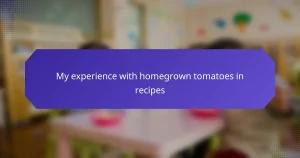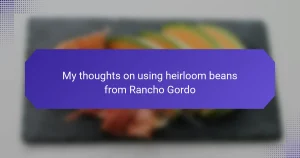Key takeaways
- A sourdough starter is a natural leavening agent made of wild yeast and bacteria, enhancing bread’s flavor and texture.
- Patience and proper technique are essential in sourdough baking, including understanding starter activity and fermentation timing.
- Using high-quality tools, like a kitchen scale and a reliable mixing bowl, can significantly improve baking outcomes.
- Sharing sourdough recipes, such as country loaves and pancakes, brings joy and fosters connections with family and friends.
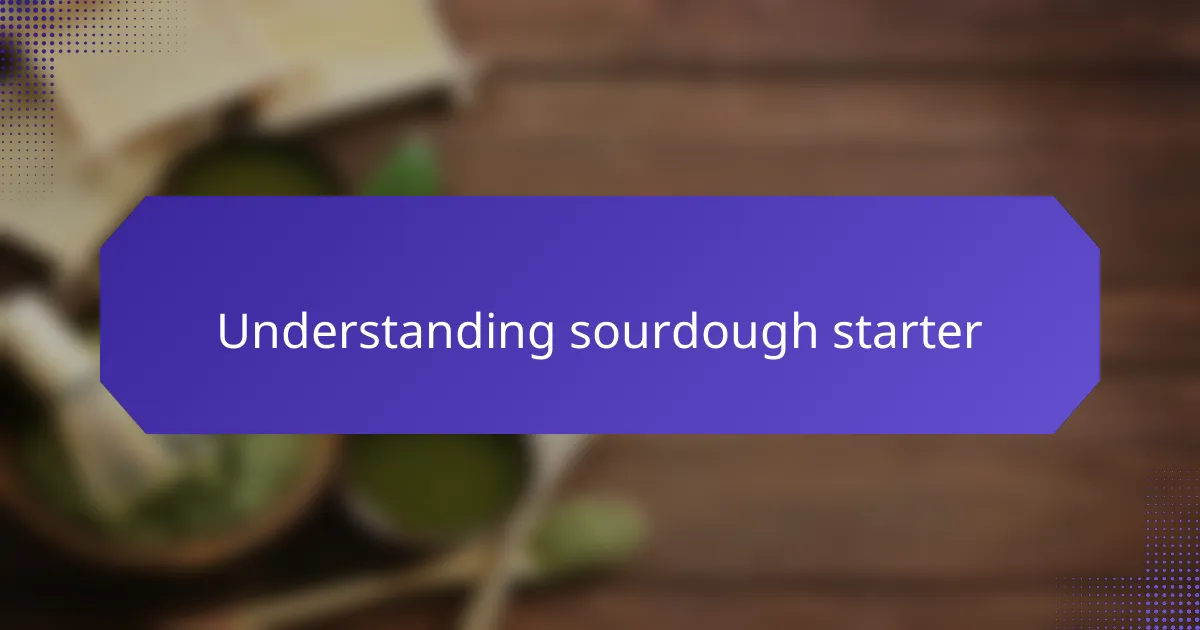
Understanding sourdough starter
To really get what a sourdough starter is, think of it as a little ecosystem of wild yeast and bacteria. I remember the first time I created one; it felt like I was nurturing a pet. There’s something surprisingly rewarding about watching flour and water transform into a bubbly, active mix over a few days.
The magic of the starter lies in its ability to leaven bread naturally. Isn’t it fascinating how these microscopic organisms work with gluten to create texture and flavor? Seeing my dough rise, thanks to that starter, was one of those moments when I truly felt the art of baking come alive in my kitchen.
As I delved deeper into sourdough, I learned that patience is key. It’s not just about the ingredients; it’s about the process and the rhythm of feeding your starter regularly. Have you ever felt that sense of connection to what you bake? That’s exactly what happened to me as I developed a bond with my starter, ensuring it was always happy and bubbly before each baking session.
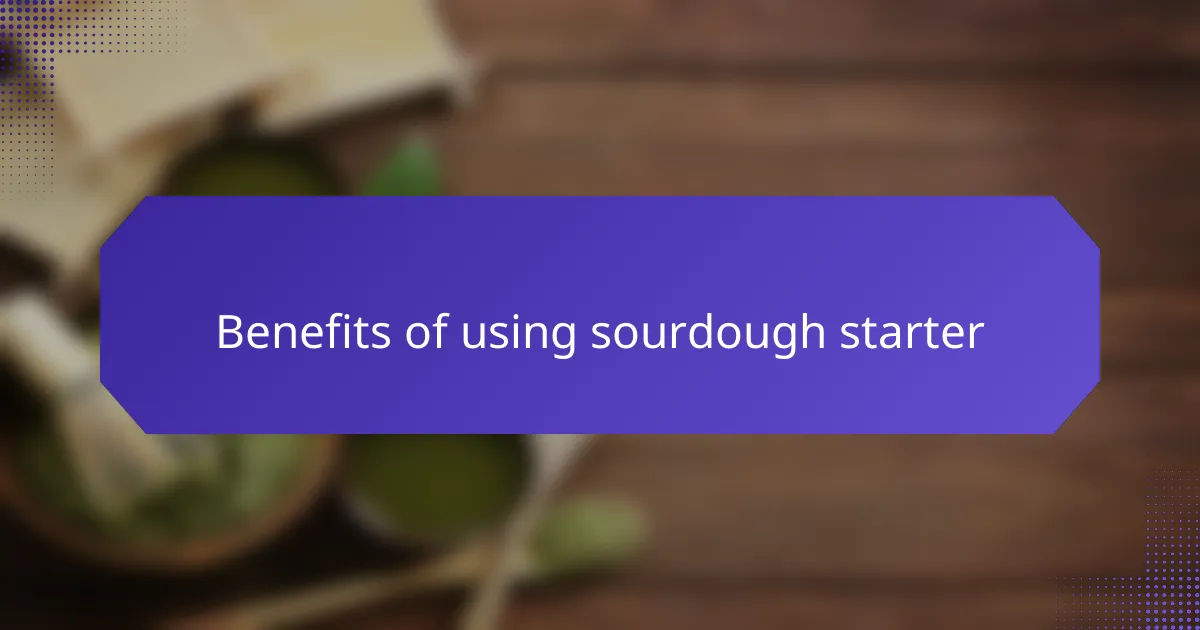
Benefits of using sourdough starter
Using sourdough starter has genuinely transformed my baking experience. One of the biggest benefits is the depth of flavor it brings to bread—there’s something so satisfying about the tanginess that develops during fermentation. Plus, knowing that I’m using a natural leavening agent makes me feel more connected to the art of baking.
Another benefit I’ve noticed is the improved texture of my bread. The crust comes out beautifully crisp, while the interior remains soft and chewy. I remember the first time I pulled a loaf out of the oven—I was filled with such pride, knowing I’d created something so wholesome and delicious from just flour, water, and time.
Lastly, using sourdough starter is fantastic for digestion. The fermentation process breaks down gluten and makes nutrients more accessible. Sometimes, I think about how I’m not just baking but also nurturing my body and sharing something meaningful with my family and friends.
| Benefit | Description |
|---|---|
| Flavor Enhancement | Adds tanginess and rich flavor through natural fermentation. |
| Texture Improvement | Creates a crisp crust and a soft, chewy interior. |
| Digestive Benefits | Helps break down gluten and improves nutrient absorption. |
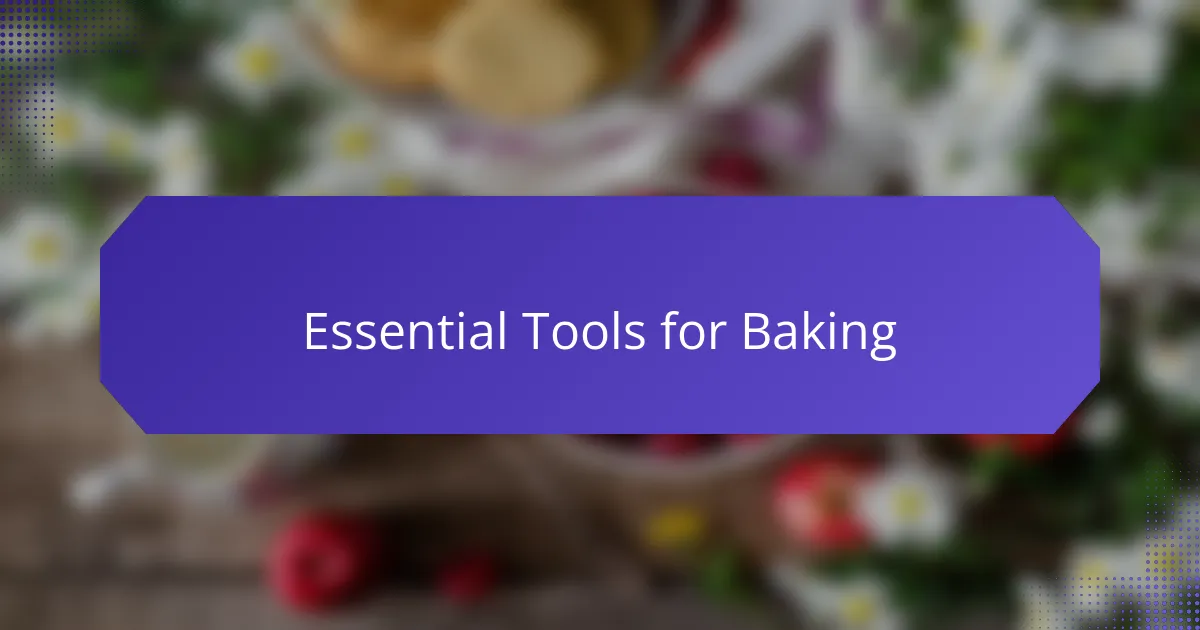
Essential tools for baking
When it comes to baking, having the right tools can make all the difference. A good quality mixing bowl, for instance, is essential for combining ingredients without creating a chaotic mess. I still remember the first time I used a sturdy glass bowl—it felt like a game-changer. The weight of it gave me confidence as I vigorously mixed my dough, and I could easily see how the ingredients came together.
Another must-have is a kitchen scale. While measuring cups can be helpful, weighing ingredients allows for precision, especially in sourdough where ratios are critical. I learned this the hard way when my first loaf didn’t rise as I’d hoped. Now, I weigh everything, and there’s a sense of satisfaction in achieving consistent results time after time. Have you ever experienced that moment when everything just clicks in the kitchen? That’s what proper tools enable!
Lastly, a bench scraper is a gem in any baker’s toolkit. It’s perfect for transferring dough to your baking surface, and it helps keep everything tidy. I can’t tell you how many times it’s saved me from a sticky clean-up after kneading. It’s funny how a simple tool can enhance the joy of baking; it’s these little joys that keep me returning to the kitchen with excitement.
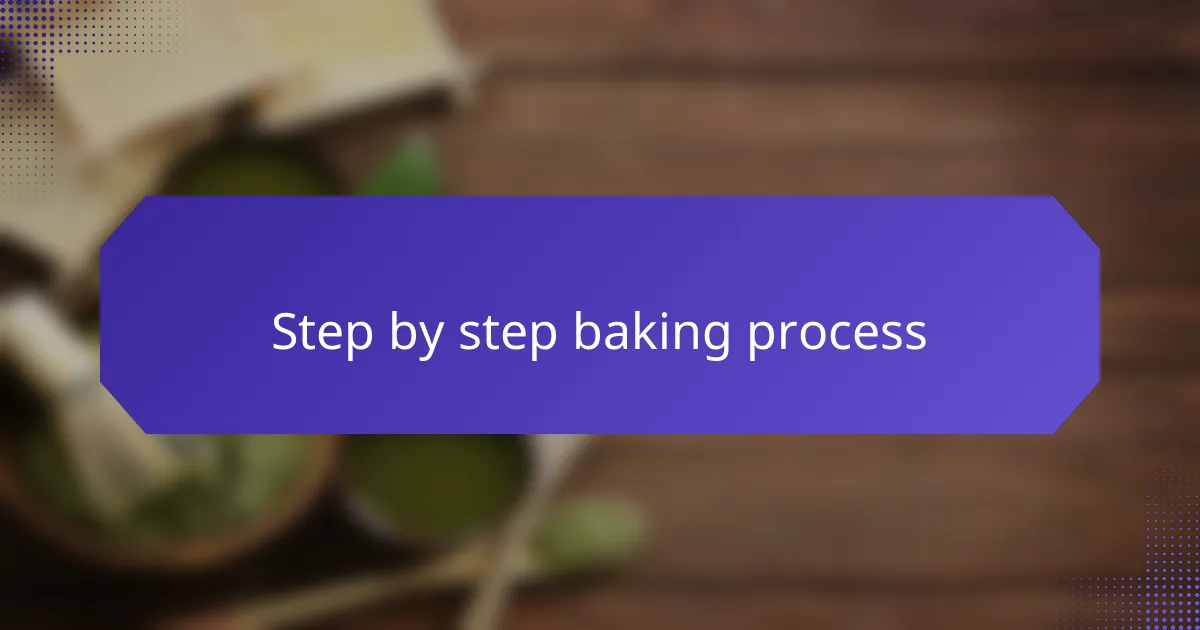
Step by step baking process
When I first started with sourdough, the baking process felt a bit overwhelming, but I soon realized that breaking it down into manageable steps made all the difference. My first few loaves were a mix of excitement and anxiety, especially waiting for the dough to rise. Through practice, I discovered that patience is key, allowing the natural fermentation to work its magic.
Here’s a simple step-by-step guide to help you navigate the sourdough baking process:
- Feed your starter: Make sure your sourdough starter is active and bubbly. This is crucial for the rise.
- Mix ingredients: Combine flour, water, salt, and your starter in a bowl. I find that using a wooden spoon helps me connect with the dough.
- Knead the dough: Gently knead until the dough is smooth and elastic, which takes about 10-15 minutes for me.
- First rise: Place the dough in a greased bowl, cover it, and let it rise for 4-12 hours, depending on the temperature of your kitchen. I usually do this overnight.
- Shape and second rise: Shape your dough into a ball and let it rise again for about 1-2 hours. This is when the anticipation builds for me.
- Preheat your oven: Heat your oven to 450°F (232°C) about 30 minutes before baking for that perfect crust.
- Bake: Place the dough in a Dutch oven and bake for 30 minutes covered, then another 15-20 minutes uncovered to achieve a golden color. The aroma during this stage is truly inspiring.
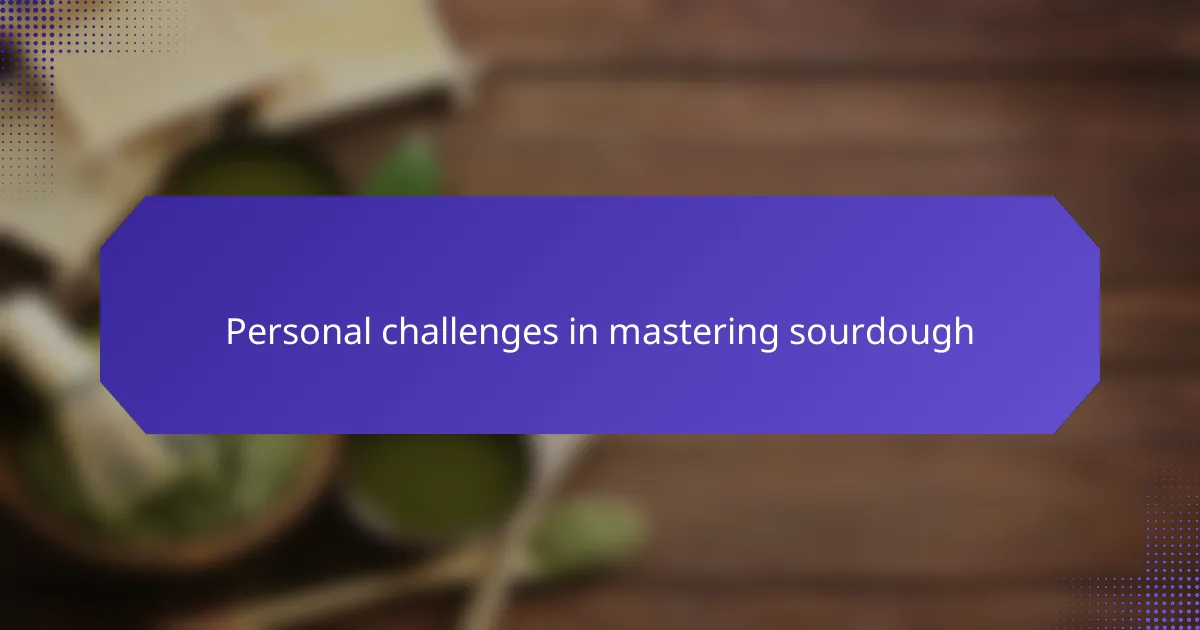
Personal challenges in mastering sourdough
Mastering sourdough baking was not without its challenges. I vividly remember the first time I opened my oven to find a flat, uninspired loaf instead of the beautifully risen bread I had envisioned. It felt disheartening, but each setback was a lesson in patience and perseverance.
Another obstacle was learning to read my starter’s signs. It took time to understand when it was at its peak and ready for baking. There were moments of doubt, wondering if I’d ever get the perfect rise, but every small success fueled my passion.
Baking with sourdough is as much a mental journey as it is a culinary one. Each loaf tells a story of trials and triumphs, making the process all the more rewarding.
| Challenge | My Experience |
|---|---|
| Inconsistent Rising | First few loaves were flat; learned the importance of timing and temperature. |
| Starter Management | Took time to understand peak activity; now I can read my starter like a book. |
| Shaping Technique | Early loaves had weird shapes; practice made a noticeable difference. |
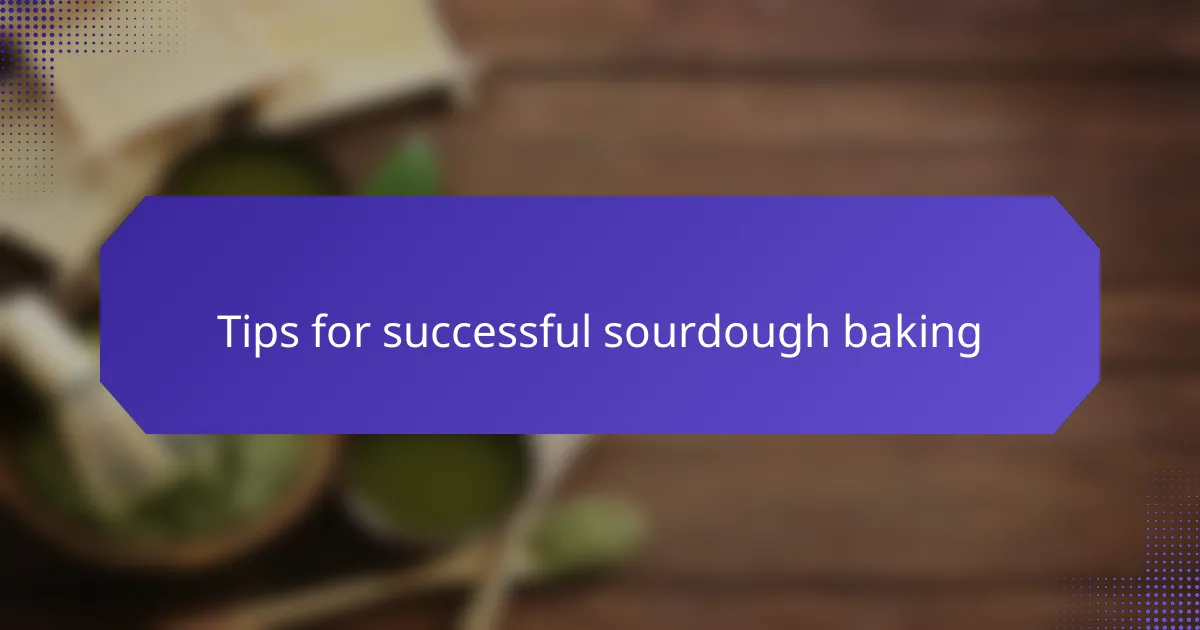
Tips for successful sourdough baking
When baking with sourdough starter, patience is your best friend. I remember my first attempts were filled with trial and error, but I learned that allowing the dough to rise slowly at room temperature yielded the best results. The fermentation process is key; it not only develops flavor but also improves the texture, giving your bread that delightful chewiness.
Understanding your starter’s strength is crucial. A well-fed starter will create a more robust rise, while an underwhelming one might leave your loaf flat. I often conduct a “float test” by dropping a spoonful of starter in water; if it floats, it’s ready to use. This simple check has saved me from many disappointing baking sessions!
Finally, don’t shy away from adjusting hydration levels in your dough. I’ve found that wetter doughs lead to a more open crumb, which I absolutely adore. It might be messy to work with, but the results are worth it, creating bread that feels and tastes artisanal.
| Tip | Importance |
|---|---|
| Be Patient | Allows for proper fermentation and flavor development |
| Check Your Starter Strength | Ensures a good rise and texture |
| Adjust Hydration Levels | Improves crumb structure and taste |
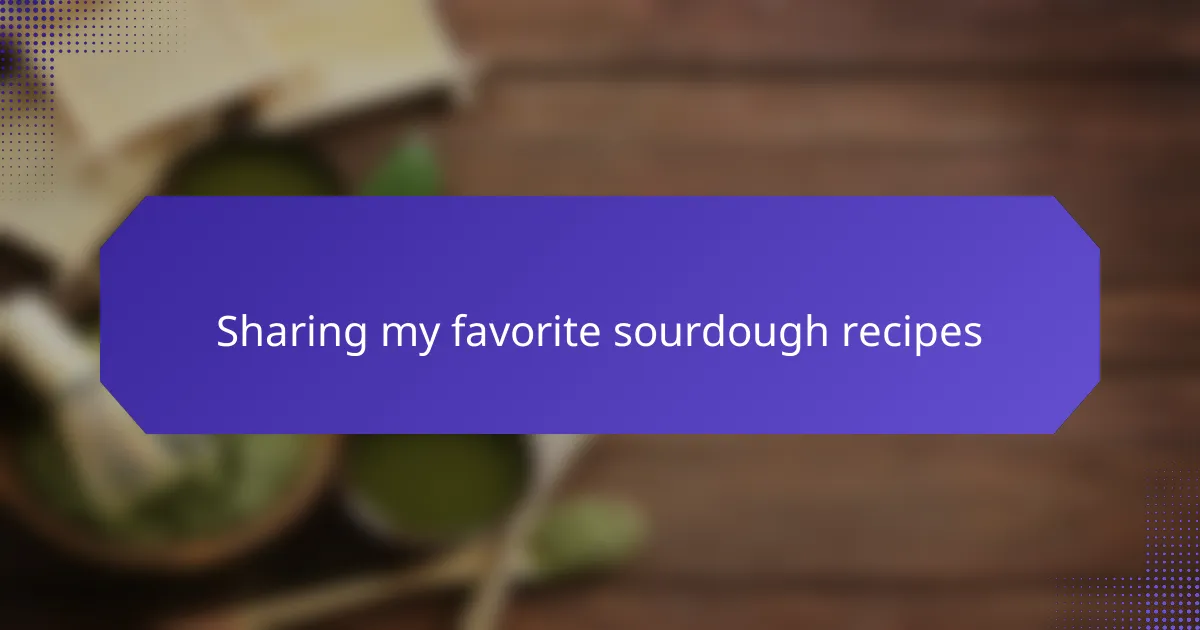
Sharing my favorite sourdough recipes
Sharing my favorite sourdough recipes brings me so much joy. One of my go-to recipes is a classic sourdough country loaf. It’s simple yet so satisfying. The process starts with a robust starter, and there’s something mesmerizing about shaping the dough. Each time I see it rise, I feel a swell of anticipation. Have you ever watched dough come to life? That moment makes all the effort worthwhile.
Another recipe I adore is sourdough pancakes. I remember the first time I tried using my sourdough starter for breakfast. The pancakes turned out light, fluffy, and with a delightful tang that made each bite feel special. The best part? Using leftover starter rather than tossing it out gave me a chance to enjoy the fruits of my labor every morning.
Of course, I can’t forget about sourdough breadsticks. They’re perfect for snacking or as an appetizer. The crispy exterior and soft interior always leave me wanting more. I often find that serving them straight from the oven invites a chorus of compliments—nothing feels better than sharing my baked creations with family and friends!
